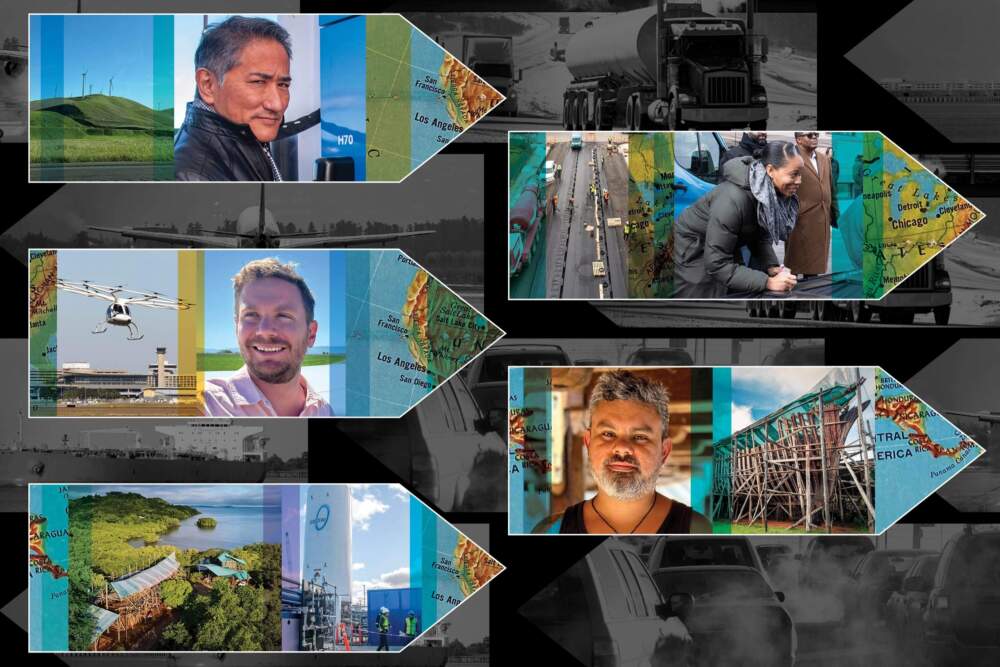Advertisement
Reverse Course: Individual action to combat climate change

Wireless charging for cars is here
People are taking steps big and small to move the dial on climate change.
In our Reverse Course: A Here & Now Climate Series, senior editor Peter O’Dowd and producer Chris Bentley take listeners across the country for a closer look at projects designed to make an impact.
Episode breakdown
Episode 12. Detroit debuts 'road of the future' with wireless EV charging: Detroit is testing a new way to charge electric vehicles that doesn’t require plugging in: Just park or drive your car on the right strip of road and watch the battery meter tick up.
The inductive-charging road spans a quarter mile and opened last year.
Episode 11. Shipbuilders harness the wind to clean up global shipping: Shipping goods by sea on large container ships creates about 3% of the world's greenhouse gas emissions each year.
In pursuit of a cleaner alternative, some companies are using wind power to move cargo.
Episode 10. Planes pollute the planet, but new technology could clean up the aviation industry: Big commercial airliners are some of the fastest-growing sources of climate-warming pollution on the planet.
Scientists and entrepreneurs are trying to solve that problem with sustainable aviation fuels, such as electric batteries and hydrogen.
Episode 9. Battery-powered big rigs could haul the future of trucking: Big trucks make up only about 10% of all vehicles on the road, but they spew almost a quarter of the climate pollution from the U.S. transportation sector.
Switching to electric or hydrogen-powered vehicles could make a huge impact, but getting there might be a long haul.
Episode 8. A 'concrete' solution to climate change: A direct-air-capture plant opened last month in Tracy, California, which will pull up to 1,000 tons of carbon dioxide directly out of the air each year.
The company that built it says the removed carbon will be permanently sequestered inside concrete. We went to a concrete plant in San Jose to understand how it works.
Episode 7. These machines suck planet-warming carbon right out of the air: Scientists are looking toward carbon removal or ideas to pull greenhouse gasses right from the atmosphere.
NPR's Camila Domonoske joins us to talk about direct air capture, or machines that can pull carbon dioxide out of the atmosphere.
Episode 6. Climate change is ravaging the oceans. Some startups see a solution in marine carbon capture: As money pours into companies promising to take greenhouse gasses out of the atmosphere, there’s a small but fast-growing sector of startups that want to leverage one of the world’s biggest carbon sinks to clean up humanity's climate pollution: the ocean.
Some scientists and entrepreneurs are developing ways to enhance the ocean's natural ability to take carbon dioxide out of the atmosphere.
Episode 5. How spreading rock dust on farms could be a climate solution: As world leaders gather in Dubai for the United Nations climate conference, one idea getting attention is carbon removal, or ways to take back some of the greenhouse gasses that humanity has already put into the atmosphere.
Some companies are building businesses on a plan to "enhance" rock weathering, one natural pathway that moves carbon from the atmosphere into deep pockets of the Earth.
Episode 4. Water vapor harvesting in Navajo Nation and Texas: In arid climates, people in need of drinking water are drawing water vapor from the air. Up to 30% of the homes on the Navajo Nation still go without running water. It’s a similar challenge in the rural borderland colonias of Texas, where thousands of people have struggled for generations to find the most basic ingredient for life.
But there’s new hope for many of these arid communities. They’re using solar-powered machines to pull moisture straight out of the air. Each one creates more than a gallon of fresh drinking water every day. The Navajo Nation has helped install more than 500 of these machines in homes on the reservation, and the technology is also now used in the Texas borderlands.
Episode 3. Tapestry of microgrids in Puerto Rico: Last year, Hurricane Fiona knocked out electricity across Puerto Rico and exposed how vulnerable Puerto Rico's electrical grid remains, nearly six years after the unprecedented damage of Hurricane Maria. Many Puerto Ricans want to break free from the cycle of destruction by building a decentralized grid powered largely by solar energy. They say the government is not doing enough to hasten that transition. One school, community and co-op at a time, residents are opting into renewable energy.
Episode 2. Capping oil and gas wells in Louisiana: Abandoned wells are belching planet-warming methane. Plugging them could be low-hanging fruit for climate action and environmental justice.
Millions of leaky wells are seeping greenhouse gasses into the atmosphere, creating a slow-motion climate disaster that should be relatively easy to fix. One problem? There are more than 120,000 of these abandoned oil and gas wells that have no known owner, and thus no one is responsible for cleanup.
The Biden Administration acknowledged the problem in the Inflation Reduction Act in 2022 and threw billions of dollars at it.
Episode 1. Forest migration in Minnesota: Wanted: A heat-tolerant tree to replenish Minnesota’s forests. Conservationists agree that Minnesota presents a unique opportunity to combat climate change. Up to a million acres in the northern part of the state could be reforested with trees to suck planet-warming carbon out of the atmosphere.
But there’s a hitch. Many of the trees in Minnesota’s boreal forest won’t survive as temperatures warm. Researchers in Minnesota are undertaking something called “assisted migration” to bring new kinds of trees to the state that are expected to do well as the climate evolves.
A visit to the Northwoods of Minnesota reveals what’s at stake.
How to listen
- Radio: Tune in for a new episode on your local NPR station during Here & Now.
- Podcast: Find a special episode of Here & Now Anytime, anywhere you get your podcasts.
This article was originally published on June 07, 2023.

